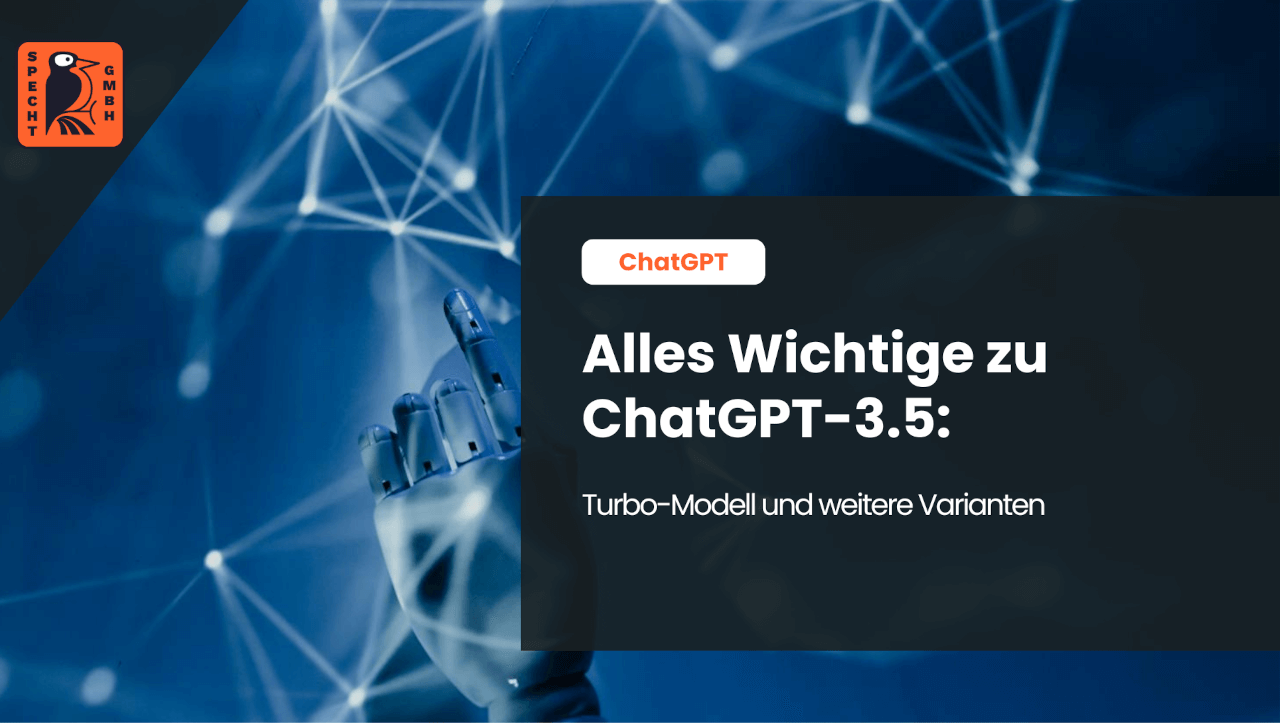ChatGPT is the AI chatbot with which users can have human-like conversations and give the user tasks: from solving mathematical tasks to creating texts and analyzing content. The chatbot is based on different versions of language models.
The language model that made ChatGPT famous worldwide and generated more than one million users within a week of its release in November 2022 is GPT-3.5. The AI model has been further developed. There are now (as of July 2024) several variants of the model.
In this blog post, we will tell you everything you need to know about the model, its different versions and its replacement with the newer GPT-4o Mini.
What is the current situation?
The GPT-3.5 model and almost all of its versions were discontinued in July 2024. Only the Turbo model can be used to a limited extent. The reason for the discontinuation of the GPT-3.5 version is its replacement by the more powerful GPT-4o Mini model.
Some background information is important for a better understanding of the models and the content of this blog post. Here is a summary of the most important information:
- When using the language models, a distinction must be made between two different offers from OpenAI.
- One offer is the chatbot called ChatGPT. You can get a closer look at the chatbot in our ChatGPT tool. You ask the chatbot tasks or questions and it responds to them.
- The other offering is the OpenAI API, a programming interface. This differs from the chatbot in that developers can use it to integrate the language model into their development environment.
- It therefore makes a difference whether the users of a language model are, for example, students or authors who research using ChatGPT or whether they are developers who only use the AI model individually.
-
Free
SEO strategy meeting
In a free SEO strategy talk, we uncover untapped potential and develop a strategy to help you become more successful on Google.

- More organic visibility
- More organic visitors to your website
- More inquiries & sales
The current situation for chatbot users
If you are interested in the ChatGPT chatbot, which you can query like a search engine using a simple input field, you can no longer use the GPT-3.5 model. It has been completely replaced by the GPT-4o Mini and GPT-4 models.
By replacing GPT-3.5 with the newer GPT-4o Mini model, you benefit from a faster response output, a generally higher quality of the chatbot and a higher number of functions. This goes hand in hand with a higher accuracy of the answers. In addition, the new versions of the AI model have been trained with more up-to-date data.
The company OpenAI has fully integrated the new GPT-4o Mini model into its free plan as standard. The free plan also gives you limited access to the flagship GPT-4o model. The fee-based "ChatGPT Plus" plan also no longer includes GPT-3.5; there you have unlimited access to the GPT-4, GPT-4o Mini and GPT-4o models.
The current situation for developers
Developers still have access to the GPT-3.5 Turbo model, but no longer to the older GPT-3.5 models. The Turbo model is available in two variants:
- GPT-3.5 Turbo 0125
- GPT-3.5 Turbo Instruct
Both models differ in their context window. The context window indicates how many tokens a language model can process in a request - in other words:
The larger the context window, the more information a GPT model can process in a specific context. A large context window, for example, promotes coherent communication and therefore the quality of the answers.
If the context window is small, an AI model will not be able to talk coherently about a topic or perform a task over a longer period of time. Users then have to make a new entry and set the task again.
At just under 16,000 tokens (16k tokens), the context window of GPT-3.5 Turbo 0125 is significantly higher than that of the GPT-3.5 Turbo Instruct model, which only reaches 4k tokens.
Developers can use GPT-3.5 Turbo in the two versions mentioned. However, the OpenAI company recommends switching to the GPT-4o Mini model, as it has more performance, more features and significantly lower costs than the Turbo model. For example, GPT-4o Mini has a 128k context window, which is a significant quality boost.
General information about ChatGPT-3.5: history, features and performance data
The company OpenAI released an AI model for use by the general public at the end of 2019, namely the GPT-2 model. In view of its 1.5 billion parameters, GPT-2 was already a large language model (LLM), but was nowhere near as mature as the GPT-3.5 model, which achieved worldwide fame shortly after its release.
GPT-3.5 was trained with 17 billion parameters. Thanks to the additional deep learning technology, comprehensive neural structures are formed in this and the following AI models from OpenAI, which are networked with each other. The result is an artificial intelligence (AI) that can, for example, create its own texts, create its own images and provide individual answers to users' questions.
GPT-3.5 marked a milestone in the OpenAI model series, as the language model was easy to use thanks to the chatbot ChatGPT and could therefore be easily operated by users without IT knowledge.
In view of the fact that, with the exception of GPT-4, the AI models do not have access to current data via the internet and therefore cannot train themselves, the timeliness of the data sets from the training is an important factor in the quality assessment. The data for the 3.5 models is from September 2021. The new GPT-3.5 Turbo model was trained with data from September 2023.
Over the months following the initial release, new versions of the GPT-3.5 generation followed. The Turbo models represented a further development of GPT-3.5 and had functional enhancements. One of these enhancements offered developers the opportunity to train the AI model with their own data via so-called "fine-tuning".
GPT-3 also offered the option of individually training the AI model. In GPT-3, this was made possible by the "davinci-002" and "babbage-002" variants. However, the fine-tuning possible with GPT-3.5 Turbo was accompanied by significantly more options for individualizing the language model.
In order to maintain the security of the AI, the data had to be channeled through a security network of OpenAI and checked during fine-tuning in order to maintain the security of the AI.
Furthermore, the GPT store was introduced during the GPT 3.5 model, which replaced the previous plugin store and makes it easier for users to customize the AI model according to their own ideas. Custom GPTs are available for this purpose. In contrast to fine-tuning, users in the store do not need any IT knowledge to create individual GPTs.
Even though the more advanced GPT-4 model was released in the meantime, GPT-3.5 Turbo lasted until July 2024 and is still available to developers. However, due to its lower cost efficiency alone compared to GPT-4o Mini (the latter is 35 cents cheaper per million input tokens, for example), it is to be expected that the GPT-3.5 Turbo version, and therefore GPT-3.5 in general, will disappear completely from the scene.
GPT-3.5 Turbo is no longer available for users of the ChatGPT chatbot. The future initially belongs to the AI models GPT-4, GPT-4o Mini and GPT-4o, as well as all other new developments from OpenAI over the next few years.
- I am one of the leading SEO experts in Germany
I am known from big media such as Stern, GoDaddy, Onpulson & breakfast television and have already worked with over 100+ well-known clients successful on Google.
Google rating
Based on 185 reviews
Trustpilot rating
Based on 100 reviews
Functions and quality of GPT-3.5 Turbo
GPT-3.5 Turbo is able to perform numerous tasks. This includes the creation of content in text format.
One weakness compared to newer models such as the GPT-4o Mini and GPT-4o is the fact that the Turbo model has no multimodal capabilities. This means that the input of image, sound and video files is not possible or these are not processed by the AI.
Overall, the Turbo model has the following features and functions, among others:
- Create, analyze and translate texts
- solve mathematical problems
- Chat: Conducting simple and differentiated conversations
- Customer service
- Create images
AI benchmarks are used to evaluate the quality of AI models. Ultimately, these are nothing more than tests with a specific procedure. One important benchmark is MMLU (Massive Multitask Language Understanding), which assesses the general knowledge of the AI and its problem-solving skills.
In the MMLU benchmark, the Turbo model received a score of 69.8 percent. This benchmark illustrates the clear difference to the new GPT-4o Mini model: GPT-4o Mini scores 82 percent in MMLU. This means that the new GPT-4o Mini model, which replaces the GPT-3.5 Turbo, is far superior.
The introduction of multimodal capabilities in GPT-4o Mini is also a welcome development. The company OpenAI already provides the input of image files for GPT-4o Mini. For the future, OpenAI promises that it will also be possible to input video and audio files.
However, one of the most important changes in the successor model to GPT-3.5 Turbo is the protection against prompt injections. Prompts are commands that an AI model follows. However, prompt injections are manipulative commands, such as the command to ignore all instructions from the OpenAI developers.
The GPT-3.5 Turbo model is vulnerable to prompt injections. This is a serious problem because the instruction to disregard OpenAI's programming could lead to the AI being used and manipulated for completely different purposes. It could potentially cause damage and be exploited by hackers for their own purposes. With GPT-4o Mini, this security gap has now been closed.
Performance values of GPT-3.5 Turbo
With a context window of 16,000 tokens, GPT-3.5 Turbo 0125 is able to process approx. 21 pages of text during input and output. This is a joke compared to the 128,000 token context window of GPT-4o Mini. Nevertheless, when using GPT-3.5 Turbo, we could already see that the 16k tokens could be used to create reasonable texts and conduct a short chat.
The increase to 128k tokens for GPT-4o Mini is therefore an upgrade that is noticeable when using the chatbot and for developers when using the API.
ChatGPT now provides even more comprehensive answers and can conduct a chat over a longer period of time without losing the thread. The extended context window makes the GPT-4o Mini much more suitable for scientific work and other large-scale tasks than the GPT-3.5-Turbo model.
Another performance criterion is the question of how quickly the tokens are issued. This criterion is evaluated via the output speed. With a speed of 166-182 tokens per second, GPT-4o Mini is clearly superior to the GPT-3.5 Turbo model. No concrete data on the output speed can be found for the Turbo model, but in practice it can be seen that the model is slower.
The costs for the GPT-3.5 Turbo model are unjustifiably high in view of the performance data compared to the competition Google Gemini 1.5 Flash and Claude 3 Haiku. GPT-3.5 Turbo 0125 costs USD 0.50 for every 1 million input tokens and USD 1.50 for every 1 million output tokens. The GPT-3.5 Turbo Instruct model is even more expensive.
Developers who want to save money should opt for the new GPT-4o Mini model, as the price per 1 million input tokens is USD 0.15 and the price per 1 million output tokens is USD 0.60 - a significant saving!
Conclusion: A milestone, just before the expiration date
GPT-3.5 formed the basis for the AI boom. It was the language model that made the chatbot ChatGPT popular in Europe and around the world. The simple use of ChatGPT - enter a question in the input field and receive an answer - similar to a search engine, made it easy for users to utilize the AI for their own purposes.
GPT-3.5 was further developed over time. One notable development was the GPT-3.5 Turbo model, which initially even had a larger context window than the later flagship model GPT-4, before GPT-4 was optimized. However, the high cost of GPT-3.5 was always a key problem, especially for developers who wanted to integrate GPT-3.5 Turbo into their development environment.
With the new GPT-4o Mini, OpenAI has launched an affordable option to replace the Turbo model. GPT-4o Mini belongs to the latest generation of AI models from OpenAI and supports multimodal functions. GPT-4o Mini also brings significant price reductions, which is an immense advantage for developers.
As a result of the new model, GPT-3.5 Turbo will increasingly disappear from the scene and the latest models will take its place. GPT-3.5 Turbo no longer plays a role in the ChatGPT chatbot. For the time being, developers still have access to the API with the Turbo model.
- Do you know my SEO newsletter?
Register now and receive regular tips from the experts.

